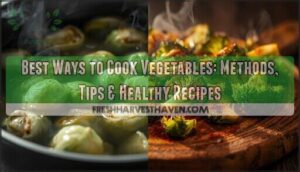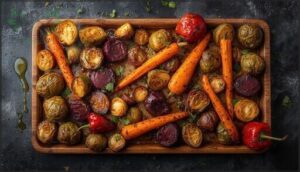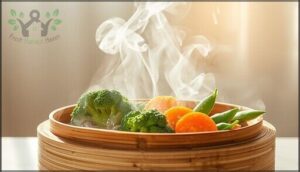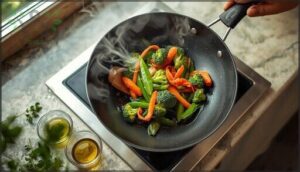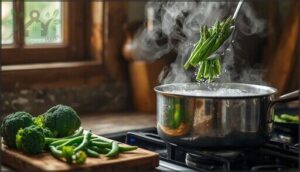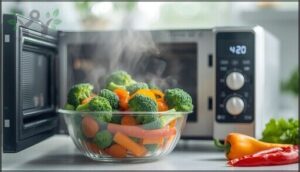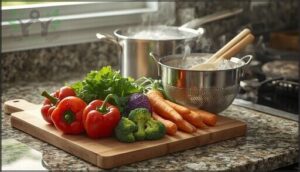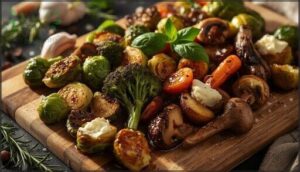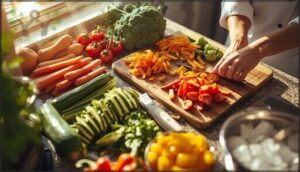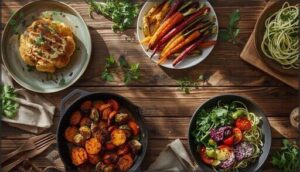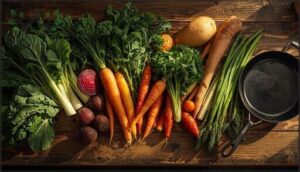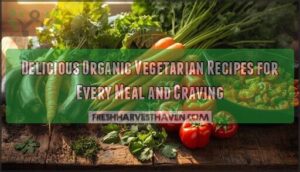This site is supported by our readers. We may earn a commission, at no cost to you, if you purchase through links.
Your mom was right—vegetables are good for you. But here’s the plot twist: how you cook them matters just as much as eating them in the first place. Toss broccoli in boiling water and watch those vitamins swim away. Roast Brussels sprouts with a drizzle of olive oil, and suddenly they’re caramelized, nutrient-packed flavor bombs.
The difference between limp, tasteless vegetables and ones you actually crave? It’s all in the technique. Master a few simple cooking methods, and you’ll discover vegetables that taste superb while keeping their nutritional superpowers intact. No more sad, soggy veggies here.
Table Of Contents
- Key Takeaways
- Popular Methods to Cook Vegetables
- Maximizing Nutrients When Cooking
- Enhancing Vegetable Flavor and Texture
- Preparation Tips for Better Cooking Results
- Creative and Healthy Vegetable Recipes
- Tips for Cooking Specific Vegetables
- Frequently Asked Questions (FAQs)
- What is the best method to cook vegetables?
- Is it healthier to bake or boil vegetables?
- Is it better to steam or air fry vegetables?
- Is it better to grill or bake vegetables?
- Can vegetables be cooked in the microwave safely?
- What cooking equipment works best for vegetables?
- How do you prevent vegetables from sticking?
- Which vegetables should never be cooked together?
- Can frozen vegetables replace fresh in recipes?
- How long do vegetables last after cooking?
- Conclusion
Key Takeaways
- Cooking method matters as much as eating vegetables—steaming and microwaving preserve up to 91% of vitamin C, while boiling can wipe out 70% of nutrients, so choose techniques that lock in nutrition without sacrificing flavor.
- Roasting at 425°F and grilling at 375-400°F unlock deep, caramelized flavors through the Maillard reaction, transforming ordinary vegetables into crave-worthy dishes with crispy edges and concentrated sweetness.
- Uniform sizing, minimal water exposure, and short cooking times (2-7 minutes for quick methods) maximize nutrient retention while achieving perfect texture, making prep work just as crucial as the cooking itself.
- Raw and cooked vegetables each offer unique benefits—raw preserves heat-sensitive vitamins like folate, while cooking boosts bioavailability of nutrients like lycopene by 164% and beta-carotene, so eating both delivers optimal nutrition.
Popular Methods to Cook Vegetables
You’ve got plenty of options for cooking vegetables, and each method brings something different to the table. Some techniques lock in nutrients, while others dial up the flavor or give you that perfect char.
Let’s walk through the most popular ways to cook your veggies so you can pick the right method for whatever you’re making.
Roasting for Enhanced Flavor
Roasting vegetables at 425°F transforms ordinary produce into something exceptional. You’ll release deep, caramelized flavors through the Maillard reaction—where natural sugars meet high heat to create those irresistible crispy edges.
This oven roasting technique preserves nutrients better than boiling while intensifying sweetness in root vegetables like carrots and Brussels sprouts. The secret? Even spacing prevents overcrowding, ensuring proper caramelization and maximum flavor enhancement.
For best results, understanding roasting techniques is essential for achieving perfectly cooked vegetables.
Grilling for Smoky Taste
While roasted veggies satisfy, grilling takes flavor to the next level with that irresistible smoky taste. Set your grill temperature to 375–400°F for perfect char formation and those gorgeous grill marks everyone loves.
Try grilled cabbage steaks, grilled zucchini with ricotta walnuts, or a grilled romaine wedge. Your vegetable selection matters—peppers, squash, and mushrooms excel in summer grilling recipes, especially grilled stuffed peppers.
For enhanced flavor, consider using smoky grilling techniques to heighten your dishes.
Steaming for Nutrient Retention
While grilling brings flavor, steaming preserves what matters most—the vitamins and minerals your body needs. This gentle steam cooking method keeps up to 90% of vitamin C intact, far better than boiling’s measly 0-73% retention rate.
Steaming locks in up to 90% of vitamin C, preserving nutrients far better than boiling ever could
Why steaming wins for nutrient preservation:
- No water contact means water-soluble vitamins stay put
- Gentle heat protects delicate nutrients from breaking down
- Minerals like calcium and potassium don’t leach away
- Natural colors and flavors shine through beautifully
You’ll taste the difference immediately.
Sautéing and Stir-Frying
When you want speed without sacrificing nutrition, sautéing and stir-frying are your best friends. These cooking techniques preserve 95% of nutrients in cruciferous veggies—beating boiling by a mile.
Heat control matters: keep temperatures moderate (80–120°C) and cook for just 2–4 minutes. Oil selection counts too. Stick with olive or avocado oil for nutrient preservation and flavor development.
Your sautéed vegetables stay crisp, colorful, and packed with antioxidants.
Boiling and Blanching
Although boiling vegetables is simple, it comes with a cost—you’ll lose up to 70% of vitamin C and other water-soluble vitamins into the cooking water. Blanching offers a smarter middle ground.
This quick 1-5 minute dip in hot water (following industry standards) reduces nutrient loss to under 20% while improving safety aspects by lowering bacteria.
Both cooking methods change texture, but blanching preserves more color and crispness.
Microwaving for Quick Cooking
When you’re short on time, microwaving shines as a surprisingly nutritious cooking method. It retains up to 91% of vitamin C—far better than boiling—while keeping minerals like calcium and magnesium intact.
The trick? Use minimal water, cover your dish, and cook for just 2-7 minutes. You’ll preserve texture and color while getting quick meals on the table fast.
Maximizing Nutrients When Cooking
You’ve chosen your cooking method, but here’s the thing: how you cook can make or break the nutritional value of your veggies. Some techniques lock in vitamins and minerals, while others send those nutrients straight down the drain.
Let’s look at smart strategies to keep your vegetables as nutritious as they’re delicious.
Choosing The Right Cooking Method
Think of choosing your cooking method as picking the right tool for the job—each one affects nutrient retention, flavor profile impact, and texture differently. Microwaving keeps up to 91% of vitamin C intact, while boiling can wipe it out completely.
Here’s how cooking methods stack up:
- Microwaving: Best for nutrient retention and cooking time efficiency
- Steaming: Preserves vitamins and phytochemicals moderately well
- Roasting: Enhances sweetness but may reduce some nutrients
- Sautéing: Quick cooking technique with good texture considerations
- Boiling: Convenient but causes significant mineral and vitamin loss
Your recipe compatibility matters too—delicate greens do better steamed, while root vegetables shine when roasted.
Minimizing Water and Heat Exposure
The less water and heat you use, the more nutrients stay in your veggies. Steaming and sautéing with minimal water protect vitamin C retention far better than boiling, which can leach up to 70% of vitamins into cooking liquid you’ll probably toss.
Try cooking whole vegetables when possible—they lose fewer nutrients than chopped pieces. Short exposure to heat matters too. Rapid cooking methods preserve those heat-sensitive vitamins you’re after.
Cooking Times and Temperature Tips
Getting your cooking time and oven temperature right keeps nutrients locked in. Roasting temperatures between 400–450°F give you tender veggies in 15–40 minutes, depending on hardness.
Steaming durations of 5–10 minutes protect over 80% of vitamins. Microwaving guidelines suggest 3–5 minutes for most vegetables, preserving nutrients better than boiling.
These cooking techniques hit texture benchmarks while maximizing nutrient retention.
Benefits of Raw Vs. Cooked Vegetables
You’ll get the most from your vegetables by eating both raw and cooked. Here’s why this combo matters for healthy eating:
- Raw vegetables deliver peak vitamin retention – especially folate and vitamin C – keeping nutrients intact without cooking losses.
- Cooked vegetables boost nutrient bioavailability – cooking tomatoes increases lycopene by 164%, and carrots release more beta-carotene.
- Both reduce disease risk – raw intake cuts mortality 12%, while cooked vegetables lower it 13%, supporting antioxidant capacity and digestibility safety.
Enhancing Vegetable Flavor and Texture
You’ve nailed the nutritional side of cooking vegetables, but let’s be honest—flavor and texture are what make you actually want to eat them. The right seasonings, herb pairings, and cooking techniques can turn boring veggies into something you’ll crave.
Here’s how to make your vegetables taste as good as they’re for you.
Seasoning and Marinating Techniques
You can bring out remarkable flavor profiles with simple seasoning and marinating techniques. Acidic marinades—think citrus or vinegar—soften vegetables while boosting moisture retention.
For flavor enhancement, try pairing garlic powder, onion powder, and black pepper, the top three choices for creative cooking techniques.
Dense veggies like carrots need 30 minutes to overnight, while delicate ones only require 10 minutes for herbal infusions and flavorful food combinations.
Creating Texture Contrasts
After marinating comes the fun part: playing with texture. Combining soft purees with crispy roasted vegetables boosts your dish’s appeal by up to 30%—think creamy cauliflower mash topped with crunchy air fryer Brussels sprouts.
Try stir-frying or sautéing to keep that tender-crisp bite, or layer grilled zucchini over silky hummus. These cooking techniques for vegetables create contrast that makes every forkful interesting.
Pairing Herbs and Spices
The right herb combinations can work wonders for flavor enhancement and aroma boosting. Basil pairs beautifully with tomatoes, while sage transforms broccoli and carrots into flavorful vegetable preparations. This spice blending approach isn’t just about taste—it aids nutrient boosting and healthy eating too.
Try these winning pairings for flavorful meals:
- Chives with zucchini or carrots
- Cilantro on tomatoes and lettuce
- Parsley with asparagus or carrots
- Oregano on roasted cauliflower
Balancing Sweetness and Bitterness
Your cooking method shapes how sweet or bitter your vegetables taste. Roasting brings out natural sweetness through caramelization while cutting bitterness by about 17% compared to boiling.
For stubborn bitter flavors, try a pinch of salt or a drizzle of sweet vinaigrette—these simple tweaks create palatability improvement and better flavor balance. Even picky eaters notice the difference in roasted vegetables!
Preparation Tips for Better Cooking Results
Before you even turn on the stove, how you prep your vegetables makes all the difference in how they cook. A few smart moves in the kitchen—like cutting everything the same size or giving veggies a quick blanch—can turn an okay dish into something really delicious.
Let’s walk through the prep steps that’ll set you up for success every time.
Peeling and Chopping Best Practices
You don’t need fancy gadgets to prep vegetables—just a sharp knife and good habits. Sharp blades cut through veggies with 36% less force, reducing hand fatigue and accidents. Use the claw grip (fingertips tucked under) to protect yourself while chopping.
Peeling techniques matter too: removing only thin layers preserves up to 25% more nutrients.
Wash your hands before and after food preparation to reduce contamination by 80%.
Uniform Sizing for Even Cooking
Ever wonder why some pieces turn mushy while others stay crunchy? Uniform sizing solves this kitchen puzzle. When you cut vegetables to similar sizes, you’ll see these benefits:
- Cooking time drops by up to 50% for smaller, even pieces
- Nutrient retention improves by 18% with consistent heating
- Texture consistency increases by 40% across your dish
- Food safety strengthens as everything reaches 75°C
- Kitchen efficiency jumps 25% with better prep
Smart vegetable preparation methods make all the difference.
Marinating for Added Depth
Want your vegetables to taste restaurant-quality? Marinating unlocks that potential. Soft vegetables need just 10–30 minutes, while denser ones benefit from 30 minutes to overnight for best flavor infusion techniques and texture alterations.
These vegetable preparation methods boost aromatic intensity by 15% and improve moisture retention during cooking. Plus, marinades with acidic ingredients reduce harmful compounds when grilling—a smart safety consideration for flavorful vegetables.
Pre-cooking Techniques (Blanching, Parboiling)
Blanching benefits your vegetables in two powerful ways: it locks in nutrients while ensuring pathogen reduction. Quick dips in boiling water retain impressive amounts—microwave blanching keeps 78% of vitamin C in green peas, while steam methods preserve 92% antioxidant activity.
The best parameters? Keep it brief—15 to 20 minutes max. Longer cooking methods mean greater vitamin loss and mineral depletion.
Creative and Healthy Vegetable Recipes
Now that you’ve got the techniques down, it’s time to put them into action with recipes that actually deliver on flavor and nutrition. Whether you’re looking for impressive sides or satisfying mains, vegetables can step up to any role on your plate.
Let’s explore some creative ways to make veggies the star of your next meal.
Stuffed Vegetable Dishes
Stuffed vegetables turn humble garden produce into satisfying, nutrient-packed meals that’ve fed families across Mediterranean and Middle Eastern cultures for generations. You can hollow out bell peppers, zucchini, or eggplants and fill them with grains, lentils, or meat—baking at 400°F for about 40 minutes until tender.
These vegetable dishes deliver fiber, vitamins C and E, and antioxidants that support your bones and immune system.
Roasted and Grilled Vegetable Sides
Roasted vegetables and grilled vegetable sides bring out natural sweetness while boosting nutrient bioavailability—especially carotenoids your body can actually use. Toss your favorites in healthy oils like olive oil, then roast at 425°F or grill until caramelized:
- Carrots and bell peppers for beta-carotene
- Zucchini and asparagus for dietary fiber
- Brussels sprouts for antioxidants
These healthy side dishes deliver flavor enhancement with minimal calories.
Vegetable-Based Main Courses
Beyond healthy side dishes, you can make vegetables the star of your plate with vegetable-based recipes like stuffed peppers, veggie lasagna, or hearty stir-fries. These plant-based meals support nutrient balance while aligning with food trends favoring plant-based diets.
When meal planning, choose vegetarian meal options with vegetable variety—like colorful curries or sheet-pan tacos—to meet your daily intake goals and keep things delicious.
Quick and Easy Vegetable Snacks
When you’re craving something satisfying between meals, vegetable snacks deliver nutrients without weighing you down. Try these nutrient boosters:
- Veggie chips like kale crisps baked at 225°F for 20 minutes
- Hummus with colorful veggie sticks for fiber and protein
- Roasted chickpeas seasoned with your favorite spices
- Fresh wraps stuffed with crunchy vegetables
- Edamame pods for plant-based protein
These quick and easy recipes transform healthy snacks into craveable appetizer and snack ideas. Most require minimal prep—some vegetable-based recipes come together in just 5 minutes. Pair healthy dips with raw veggies, and you’ve got easy side dishes that support your wellness goals while satisfying that mid-afternoon hunger.
Tips for Cooking Specific Vegetables
Not all vegetables play by the same rules regarding cooking. What works beautifully for tender greens can turn root vegetables into a mushy mess, and vice versa.
Let’s break down the best techniques for each vegetable family so you can get perfect results every time.
Best Ways to Cook Cruciferous Veggies
Cruciferous benefits shine when you pick the right cooking methods for vegetables like broccoli, Brussels sprouts, cauliflower, and cabbage. Roasting at 425°F for 15-20 minutes creates crispy edges while preserving those cancer-fighting food compounds. Want to protect heat-sensitive nutrients? Steaming wins—it keeps vitamin C intact and boosts nutrient boosters like beta-carotene.
Veggie Prep Tips That Make a Difference
| Method | Best For |
|---|---|
| Roasting with healthy cooking oil | Flavor & crispy texture |
| Steaming (short times) | Maximum vitamin retention |
| Chop & wait 40 minutes | Sulforaphane production |
Techniques for Root Vegetables
Root vegetables like carrots, parsnips, and sweet potatoes shine when you master roasting at 400-425°F. Here’s your flavor enhancement playbook:
- Cut everything into 1-inch cubes for even cooking
- Toss with olive oil to boost fat-soluble vitamin absorption
- Roast 25-50 minutes until caramelized edges appear
- Try pre-boiling 10 minutes to speed things up
This cooking optimization balances nutrient preservation with those sweet, crispy results you’re after.
Cooking Leafy Greens Effectively
Tender greens like spinach and kale pack serious nutrition—if you cook them right. Steaming preserves the most vitamins while keeping texture bright, but here’s a surprise: frying in olive oil actually boosts antioxidants by over 100% in some leafy green varieties.
For nutrient preservation with maximum flavor, try quick sautéing (2 minutes) or steaming (under 5 minutes) to lock in those health benefits.
Methods for Summer and Winter Squash
Summer squash like zucchini shines on the grill—5–7 minutes per side at high heat boosts antioxidants by 18% while adding smoky flavor.
Winter squash varieties, including butternut, need gentler treatment: roasting at 425°F for 15–20 minutes concentrates sweetness through caramelization.
For quick nutrient preservation, microwave cooking maintains over 80% of folate, making it ideal when you’re short on time.
Frequently Asked Questions (FAQs)
What is the best method to cook vegetables?
There’s no single “best” method—steaming and microwaving boost nutrient retention (preserving 80-91% of vitamin C), while roasting and grilling improve flavor through caramelization, making vegetables irresistibly delicious.
Is it healthier to bake or boil vegetables?
Baking is healthier than boiling vegetables. Boiling causes significant mineral leaching and vitamin losses up to 70%, while baking preserves antioxidant activity and nutrient retention through minimal cooking water exposure.
Is it better to steam or air fry vegetables?
Both methods shine, but steaming edges ahead for nutrient retention—boosting glucosinolates by 30% in broccoli. Air frying delivers a crispier texture and saves energy, though it’s slightly harder on heat-sensitive vitamins.
Your taste preferences matter most!
Is it better to grill or bake vegetables?
You can grill or bake vegetables and win either way. Grilling caramelizes sugars quickly, delivering smoky flavor with fewer calories, while baking offers gentler heat and easier nutrient retention.
Can vegetables be cooked in the microwave safely?
Yes, you can safely microwave vegetables—it’s actually one of the healthiest cooking methods.
Microwaving preserves more vitamin C and antioxidants than boiling, with minimal nutrient loss when you use short cooking times and little water.
What cooking equipment works best for vegetables?
Your trusty companions in the kitchen matter more than you might think. A solid chef’s knife, steamer basket, cast iron skillet, and baking sheet handle most cooking methods—from roasting to grilling—while preserving nutrients beautifully.
How do you prevent vegetables from sticking?
Coat your vegetables evenly with high-smoke-point oils like avocado or grapeseed before cooking.
Preheat your pan properly, use parchment paper or nonstick surfaces, and avoid overcrowding—these simple techniques prevent sticking beautifully.
Which vegetables should never be cooked together?
Don’t mix and match carelessly! Cruciferous combinations with acidic pairings can disrupt digestive harmony.
Gas-producing cruciferous vegetables, root vegetable blends, and leafy greens with starches create uneven cooking vegetables and uncomfortable digestion.
Can frozen vegetables replace fresh in recipes?
Frozen vegetables work beautifully in most cooked dishes like stir-fries, soups, and casseroles. They’re often more nutritious than “fresh” veggies sitting in your fridge for days, offering excellent nutrient retention and convenience.
How long do vegetables last after cooking?
After cooking, most vegetables stay fresh in the refrigerator for three to seven days when stored properly in airtight containers. Root vegetables generally last longer, while leafy greens need eating within three to four days.
Conclusion
The proof is in the pudding—or in this case, the perfectly roasted carrots on your plate. Now that you know the best ways to cook vegetables, you’re equipped to transform any produce into something delicious and nutritious.
Whether you’re steaming broccoli to preserve its vitamins or grilling zucchini for that irresistible char, these techniques turn healthy eating from a chore into pure pleasure. Your taste buds and body will thank you.
- https://www.tandfonline.com/doi/abs/10.1080/09637486.2019.1571021
- https://www.ncbi.nlm.nih.gov/pmc/articles/PMC5707683/
- https://www.sciencedirect.com/science/article/pii/S240584402308917X
- https://www.getlabtest.com/news/post/does-steaming-vegetables-remove-nutrients
- https://www.mieleexperience.co.nz/nutrients-preserved-with-steam-cooking/

